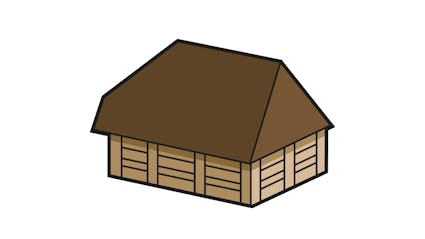352 – Cheese Storehouse from Wasen Berne, 1785
Farmers often spent much effort in erecting a building dedicated to valuable cattle or special products.

One Usage, one building
Farmers often spent much effort in erecting a building dedicated to valuable cattle or special products. Farmers who wanted to be self-sufficient and supply their own bread planted grain and built granaries and a baking oven. If animal husbandry was preferred, they built spacious stalls and barns as well as the requisite alp huts on the mountains. Farmers who produced more cheese than they needed themselves and wanted to market it needed storage room for the discs of solidified milk: The cheese storehouse was born. In the Bernese Oberland storage buildings for hard cheese arose in the 16th century.

The cheese boom
Emmentaler cheese was an item in high demand for many generations. Since cheese must be aged and treated for a few months, this cheese storehouse from Wasen in the Emmen valley had several hundred brothers and sisters. Nowadays new buildings with modern equipment are producing and storing the cheese. This storehouse which stood in open fields on the Oberen Schützenalp (1080 metres; 3543 feet) had deteriorated. It began a second life in the Ballenberg Open-Air Museum in 1982.
Mountains of cheese
Meat and grain were stored in free-standing storehouses or in storerooms in house attics. This storage space was hardly sufficient once Emmen valley farmers began to specialise in cheesemaking in the 18th century: The cows and herders on the alps produced enormous amounts of cheese wheels. Rich valley farmers and, later, urban merchants marketed them at home and abroad.
“Pure Swissness” tour
Hands-on traditional cheese-making
There’s a lot to do in the Cheese Storehouse from Wasen BE (352). Take a seat in the milking stool and try your hand at milking. Help us carefully move the cheese wheels and learn more about the ageing and storage of this Swiss cultural treasure. There is a special task for our younger visitors: they can playfully carry cheese on their backs using the traditional wooden frame. Here, too, you can slip into historical clothing and be transported back in time to 150 years ago.

Ballenberg
Swiss Open-Air Museum
Museumsstrasse 100
CH-3858 Hofstetten bei Brienz
Company holidays
24 December 2025 to 11 January 2026
Opening hours Administration
3 November 2025 to 8 April 2026
From Monday to Friday
8.30 am to 11.30 am
1.30 pm to 4.30 pm
Opening hours
9 April to 1 November 2026
10 am to 5 pm daily